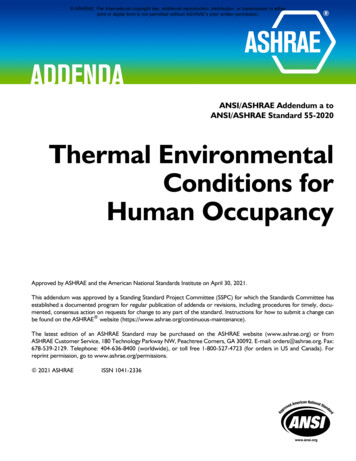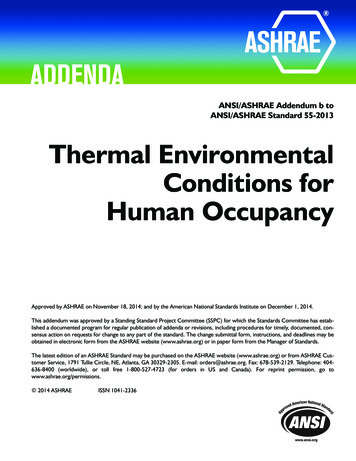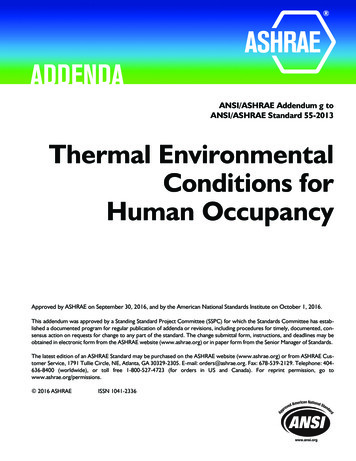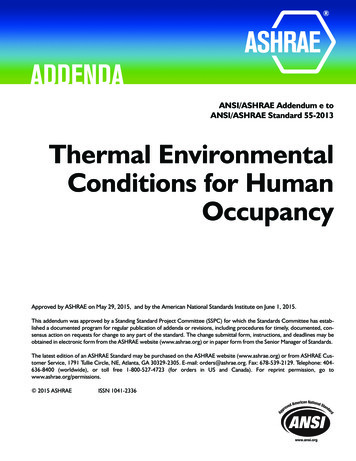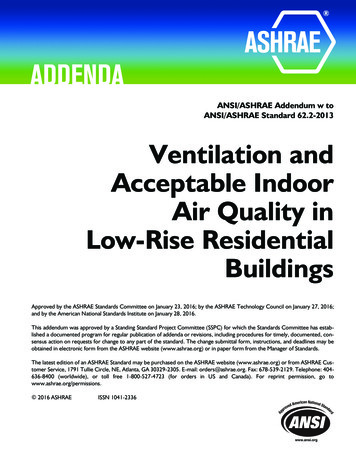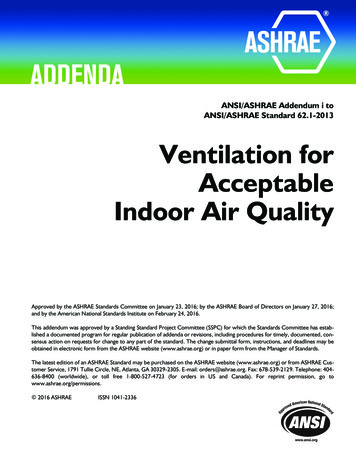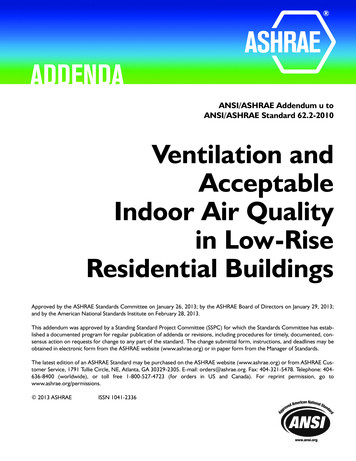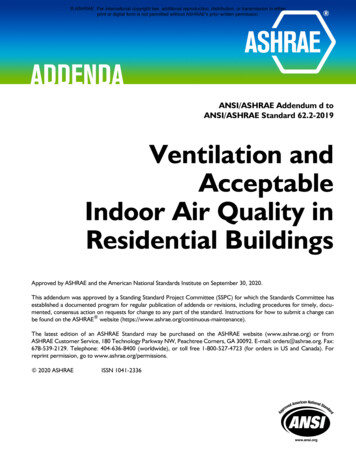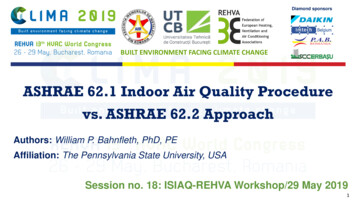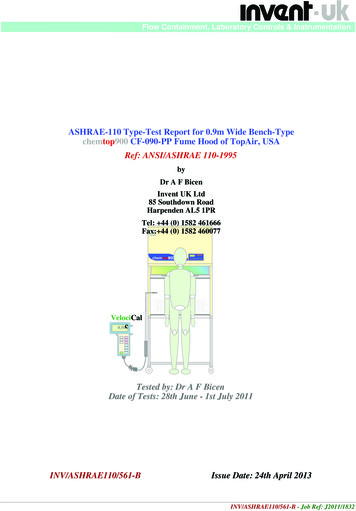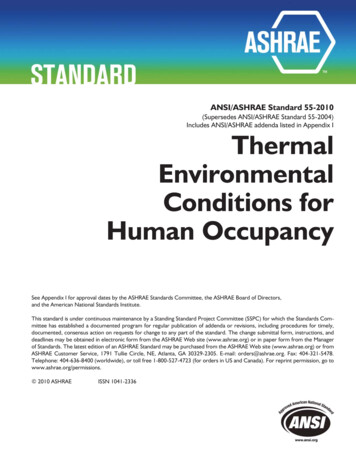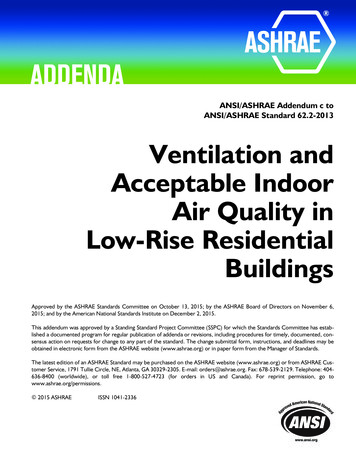
Transcription
ANSI/ASHRAE Addendum c toANSI/ASHRAE Standard 62.2-2013Ventilation andAcceptable IndoorAir Quality inLow-Rise ResidentialBuildingsApproved by the ASHRAE Standards Committee on October 13, 2015; by the ASHRAE Board of Directors on November 6,2015; and by the American National Standards Institute on December 2, 2015.This addendum was approved by a Standing Standard Project Committee (SSPC) for which the Standards Committee has established a documented program for regular publication of addenda or revisions, including procedures for timely, documented, consensus action on requests for change to any part of the standard. The change submittal form, instructions, and deadlines may beobtained in electronic form from the ASHRAE website (www.ashrae.org) or in paper form from the Manager of Standards.The latest edition of an ASHRAE Standard may be purchased on the ASHRAE website (www.ashrae.org) or from ASHRAE Customer Service, 1791 Tullie Circle, NE, Atlanta, GA 30329-2305. E-mail: orders@ashrae.org. Fax: 678-539-2129. Telephone: 404636-8400 (worldwide), or toll free 1-800-527-4723 (for orders in US and Canada). For reprint permission, go towww.ashrae.org/permissions. 2015 ASHRAEISSN 1041-2336
ASHRAE (www.ashrae.org). For personal use only. Additional reproduction, distribution,or transmission in either print or digital form is not permitted without ASHRAE's prior written permission.ASHRAE Standing Standard Project Committee 62.2Cognizant TC: 4.3, Ventilation Requirements and InfiltrationSPLS Liaison: John F. DunlapPaul Francisco, Chair*Iain S. Walker, Vice-Chair*Paul H. Raymer, Secretary*David A. Baylon*Terry M. Brennan*Gary CrawRoy R. Crawford*S. Craig Drumheller*Philip W. Fairey*Henry T. GreistSanjeev K. HingoraniMark C. Jackson*David E. Jacobs*Richard J. Karg*Glenn P. LanganJoseph W. Lstiburek*Michael R. Lubliner*Stephany I. Mason*Darren B. Meyers*James C. Moore, III*Wayne E. MorrisAmy B. Musser*John P. Proctor*Armin Rudd*Max H. ShermanSarany SingerDon T. Stevens*Thomas R. Stroud*Christine Q. SunEric D. Werling*Bruce A. Wilcox*Ted A. Williams** Denotes members of voting status when the document was approved for publicationASHRAE STANDARDS COMMITTEE 2015–2016Douglass T. Reindl, ChairRita M. Harrold, Vice-ChairJoseph R. AndersonJames D. AsweganNiels BidstrupDonald M. BrundageJohn A. ClarkWaller S. ClementsJohn F. DunlapJames W. Earley, Jr.Keith I. EmersonSteven J. EmmerichJulie M. FergusonRoger L. HedrickSrinivas KatipamulaRick A. LarsonLawrence C. MarkelArsen K. MelikovMark P. ModeraCyrus H. NasseriHeather L. PlattDavid RobinPeter SimmondsDennis A. StankeWayne H. Stoppelmoor, Jr.Jack H. ZarourJulia A. Keen, BOD ExOJames K. Vallort, COStephanie C. Reiniche, Senior Manager of StandardsSPECIAL NOTEThis American National Standard (ANS) is a national voluntary consensus standard developed under the auspices of ASHRAE. Consensus is definedby the American National Standards Institute (ANSI), of which ASHRAE is a member and which has approved this standard as an ANS, as “substantialagreement reached by directly and materially affected interest categories. This signifies the concurrence of more than a simple majority, but not necessarilyunanimity. Consensus requires that all views and objections be considered, and that an effort be made toward their resolution.” Compliance with thisstandard is voluntary until and unless a legal jurisdiction makes compliance mandatory through legislation.ASHRAE obtains consensus through participation of its national and international members, associated societies, and public review.ASHRAE Standards are prepared by a Project Committee appointed specifically for the purpose of writing the Standard. The Project CommitteeChair and Vice-Chair must be members of ASHRAE; while other committee members may or may not be ASHRAE members, all must be technicallyqualified in the subject area of the Standard. Every effort is made to balance the concerned interests on all Project Committees.The Manager of Standards of ASHRAE should be contacted for:a. interpretation of the contents of this Standard,b. participation in the next review of the Standard,c. offering constructive criticism for improving the Standard, ord. permission to reprint portions of the Standard.DISCLAIMERASHRAE uses its best efforts to promulgate Standards and Guidelines for the benefit of the public in light of available information and acceptedindustry practices. However, ASHRAE does not guarantee, certify, or assure the safety or performance of any products, components, or systems tested,installed, or operated in accordance with ASHRAE’s Standards or Guidelines or that any tests conducted under its Standards or Guidelines will benonhazardous or free from risk.ASHRAE INDUSTRIAL ADVERTISING POLICY ON STANDARDSASHRAE Standards and Guidelines are established to assist industry and the public by offering a uniform method of testing for rating purposes, bysuggesting safe practices in designing and installing equipment, by providing proper definitions of this equipment, and by providing other information thatmay serve to guide the industry. The creation of ASHRAE Standards and Guidelines is determined by the need for them, and conformance to them iscompletely voluntary.In referring to this Standard or Guideline and in marking of equipment and in advertising, no claim shall be made, either stated or implied, that theproduct has been approved by ASHRAE.ASHRAE is a registered trademark of the American Society of Heating, Refrigerating and Air-Conditioning Engineers, Inc.ANSI is a registered trademark of the American National Standards Institute.
ASHRAE (www.ashrae.org). For personal use only. Additional reproduction, distribution,or transmission in either print or digital form is not permitted without ASHRAE's prior written permission.(This foreword is not part of this standard. It is merelyinformative and does not contain requirements necessaryfor conformance to the standard. It has not been processed according to the ANSI requirements for a standardand may contain material that has not been subject topublic review or a consensus process. Unresolved objectors on informative material are not offered the right toappeal at ASHRAE or ANSI.)FOREWORDThis change aims to account for the difference between rangehoods and other exhaust fans in kitchens in their ability toremove particles. Bathroom requirements are unchanged.Note: In this addendum, changes to the current standardare indicated in the text by underlining (for additions) andstrikethrough (for deletions) unless the instructions specifically mention some other means of indicating the changes.Addendum c to Standard 62.2-2013Add the following definition to Section 3.3. DEFINITIONSkitchen, enclosed: a kitchen whose permanent openings tointerior adjacent spaces do not exceed a total of 60 ft2 (6 m2).Revise Section 5 as shown. The remainder of Section 5 isunchanged.5. LOCAL EXHAUST5.1 Local Mechanical Exhaust. A local mechanical exhaustsystem shall be installed in each kitchen and bathroom. Nonenclosed kitchens shall be provided with a demand-controlledmechanical exhaust system meeting the requirements of Section 5.2. Each local ventilation system for all other kitchensand bathrooms shall be either one of the following two:a. A demand-controlled mechanical exhaust system meetingthe requirements of Section 5.2b. A continuous mechanical exhaust system meeting therequirements of Section 5.3Exception: Alternative Ventilation. Other design methodsmay be used to provide the required exhaust rates whenapproved by a licensed design professional.5.2 Demand-Controlled Mechanical Exhaust. A localmechanical exhaust system shall be designed to be operatedas needed by the occupant.5.2.1 Control and Operation. Automatic control devicessuch as but not limited to the following are permissible provided they do not impede manual ON-OFF occupant control:shut-off timers, occupancy sensors, multiple-speed fans, combined switching, IAQ sensors, etc.5.2.2 Ventilation Rate. The minimum airflow rating shallbe at least the amount indicated in Table 5.1.5.3 Continuous Mechanical Exhaust. A continuously operating mechanical exhaust system shall be installed to operatewithout occupant intervention. The system may be part of abalanced mechanical system. See Chapter 10 of ASHRAEGuideline 244 for guidance on selection of methods.5.3.1 Control and Operation. The system shall bedesigned to operate during all occupiable hours. Readilyaccessible override control must be provided to the occupant.5.3.2 Ventilation Rate. The minimum delivered ventilationshall be at least the amount indicated in Table 5.2 during eachhour of operation.Revise Section A3.1 as shown.[ ]A3.1 Initial Room Airflow Deficit. The airflow deficit foreach bathroom shall be 50 cfm, less the airflow rating fromSection A4.2 of the exhaust equipment. The airflow deficitfor each kitchen shall be 100 cfm, less the airflow rating fromSection A4.2 of the exhaust equipment. or kitchen is therequired airflow from Table 5.1 less the airflow rating fromSection A4.2 of the exhaust equipment. If there is no exhaustdevice or if the existing device can neither be measured norrated, the exhaust device airflow shall be assumed to be zero.TABLE 5.1 Demand-Controlled Local Ventilation Exhaust Airflow RatesApplicationAirflowNotesEnclosedKitchen Vented range hood (including appliance-range hood combinations): Vented range hood (including appliance-range100 cfm (50 L/s)hood combinations) required if exhaust fan flow Other kitchen exhaust fans, including downdraft: 300 cfm (150 L/s) or rate is less than 5 kitchen air changes per hour.a capacity of 5 achNonenclosedKitchen Vented range hood (including appliance-range hood combinations):100 cfm (50 L/s) Other kitchen exhaust fans, including downdraft: 300 cfm (150 L/s)Bathroom50 cfm (25 L/s)TABLE 5.2 Continuous Local Ventilation Exhaust Airflow RatesApplicationAirflowNotesEnclosed Kitchen5 ach ach, based on kitchen volumeBased on kitchen volume.Bathroom20 cfm (10 L/s)ANSI/ASHRAE Addendum c to ANSI/ASHRAE Standard 62.2-20131
ASHRAE (www.ashrae.org). For personal use only. Additional reproduction, distribution,or transmission in either print or digital form is not permitted without ASHRAE's prior written permission.
ASHRAE (www.ashrae.org). For personal use only. Additional reproduction, distribution,or transmission in either print or digital form is not permitted without ASHRAE's prior written permission.POLICY STATEMENT DEFINING ASHRAE’S CONCERNFOR THE ENVIRONMENTAL IMPACT OF ITS ACTIVITIESASHRAE is concerned with the impact of its members’ activities on both the indoor and outdoor environment. ASHRAE’s memberswill strive to minimize any possible deleterious effect on the indoor and outdoor environment of the systems and components in theirresponsibility while maximizing the beneficial effects these systems provide, consistent with accepted standards and the practical state ofthe art.ASHRAE’s short-range goal is to ensure that the systems and components within its scope do not impact the indoor and outdoorenvironment to a greater extent than specified by the standards and guidelines as established by itself and other responsible bodies.As an ongoing goal, ASHRAE will, through its Standards Committee and extensive technical committee structure, continue togenerate up-to-date standards and guidelines where appropriate and adopt, recommend, and promote those new and revised standardsdeveloped by other responsible organizations.Through its Handbook, appropriate chapters will contain up-to-date standards and design considerations as the material issystematically revised.ASHRAE will take the lead with respect to dissemination of environmental information of its primary interest and will seek out anddisseminate information from other responsible organizations that is pertinent, as guides to updating standards and guidelines.The effects of the design and selection of equipment and systems will be considered within the scope of the system’s intended useand expected misuse. The disposal of hazardous materials, if any, will also be considered.ASHRAE’s primary concern for environmental impact will be at the site where equipment within ASHRAE’s scope operates.However, energy source selection and the possible environmental impact due to the energy source and energy transportation will beconsidered where possible. Recommendations concerning energy source selection should be made by its members.
ASHRAE · 1791 Tullie Circle NE · Atlanta, GA 30329 · www.ashrae.org12/15
08.12.2015 · ANSI/ASHRAE Addendum c to ANSI/ASHRAE Standard 62.2-2013 1 (This foreword is not part of this standard. It is merely informative and does not contain requirements necessary for conformance to the standard. It has not been pro-cessed according to the ANSI requirements for a standard and may contain material that has not been subject to public review or a consensus process.

